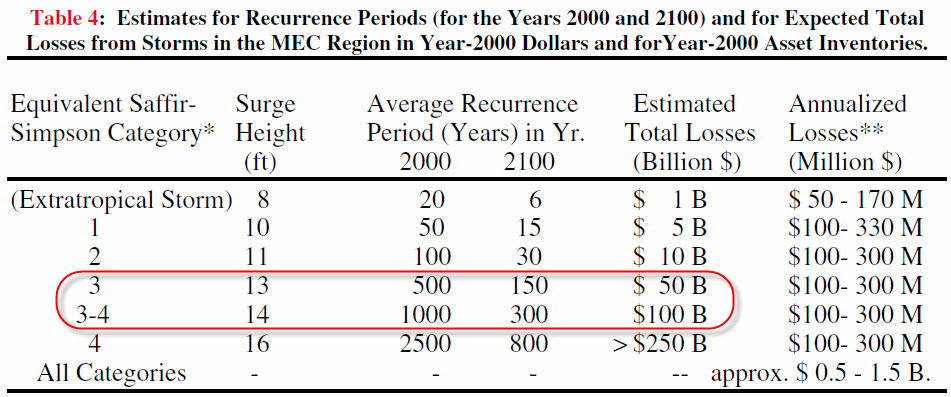– Sandy Total Loss Estimate: Up To $100 Billion (ZeroHedge, Oct 31, 2012):
In a stunningly accurate prediction of what to expect from a 100-year storm, the following 2011 report assessing the ‘risk increase to infrastructure due to a sea level rise‘ provides everything you did not want to know about just how bad the situation is with recovery from Sandy’s damage but were afraid to ask. Based on extrapolations from storm surge heights, the authors see a ‘perfect storm’ of this magnitude likely creating a total loss between $50 and $100bn. As Atlantic Cities notes, citing the report: The researchers also estimate that… it could take the subway system about 21 days to get working at 90 percent functionality. If all potential damage is considered, …that timeline could increase to several months, and that “permanent restoration of the system to the full revenue service that was previously available could take more than two years.”
Obviously these are only predictions, but the detail and prescience of the report are stunning in their accuracy now that the ‘event’ has occurred. Of course, the MTA has done whatever possible to prepare – and will do everything to get this vital infrastructure back in service but with the head of MTA noting this is the worst disaster ever, we suspect the 4-5 day estimate is over-promising.
The vast majority of New York City’s and the MEC region’s basic infrastructure (in its narrow sense of engineered structures and systems) was built and developed between about 100 and 50 years ago. This buildup occurred during the time of largest population influx, primarily driven by immigration. Today, with about 20 Million people living, working and commuting in its 31 counties, the MEC region is home to the largest public transportation system in the US...
…But without a properly functioning regional public infrastructure, private “Wall Street” and other major business sectors of the region could not exist. Infrastructure systems behave like inter-dependent growing organisms. This interdependence poses risks, however. If one system fails or under-performs, others can be severely affected…
Here is the prediction for storm surge areas:
…Note that for worst-case scenario storms stronger than Category 2, Lower Manhattan will be split into two islands, along Canal Street; i.e. the financial district would be entirely cut off from any escape routes. Entrances to subway, road or rail tunnels or ventilation shafts will be at or below flood levels, not to speak of the building stock and other assets that are located in the flooded areas…
and the prediction for the effect on the Brooklyn-Battery Tunnel
…But regardless of climate change, the increasing potential for storm-related losses due to population and asset growth is already reason enough to address those risks and look for coping and adaptation strategies…
…The Metro East Coast (MEC) infrastructure, like the infrastructure in many other large US cities with an aged inventory, has suffered for many decades from deferred maintenance. This has created a huge demand for infrastructure capital spending to restore and expand the aged systems in the MEC region and elsewhere…
All losses discussed here are total losses related to a given event. They include insured and uninsured losses. They include losses from coastal surge, riverine flooding and wind damage. They apply to the entire built environment, not just infrastructure or transportation infrastructure…
Estimated Losses $50-100bn! – based on Storm Surge extrapolations:
This is accrued loss over the next 100 years from this storm (given its probability of occurrence) – but since the storm just hit then there is no accrual! A 13-14ft Storm Surge implies a $50-100 billion total loss now!
And a rather scary sounding conclusion:
The problem of sea level rise that New York City and the MEC are about to face will be faced by coastal megacities and shore-bound populations all around the US coasts, in fact around the globe, in rich and poor countries alike. New York City and the surrounding MEC region could be in the unique position to muster the financial and intellectual resources, perhaps even the communal political wit and will (sic!) to set a world-class example for how to deal with such a fundamental societal / environmental issue. NYC and the surrounding MEC could do so in par with its often self-declared status as the ‘financial capital’ of the world. The City that never sleeps? True or not, ‘mother nature’ will see to it that wake-up calls will abound.



